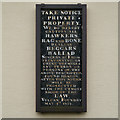1
Railway passes Vulcan Village
Image: © Anthony Parkes
Taken: 13 Feb 2014
0.08 miles
2
Vulcan Village, School Cottages
During the 1970s and 1980s, the Village became rundown and almost derelict until it was acquired by Maritime Housing Association, who refurbished and adapted the properties to modern standards. During these improvements the old foundry school was converted into three bungalows for the elderly and disabled. After the Vulcan Inn, it is the second largest building in the Conservation Area.
Image: © David Dixon
Taken: 28 Jan 2013
0.08 miles
3
Vulcan Village
The Vulcan Foundry manufactured ironwork for railways and built early steam locomotives to designs by Robert Stephenson and others. These cottages were thought to have been constructed in 1833, the 114 houses set in six terraces all named after major cities. In 1984 the houses were brought up to modern housing standards and subsequently Vulcan Village became a conservation area.
In 2002 the works closed and was demolished in October 2007, this once remote industrial village now has over 600 new houses on the adjacent works site with more under construction.
Image: © Sue Adair
Taken: 4 Feb 2020
0.09 miles
4
Take Notice: Private Property
It is thought that the construction of Vulcan Village began in 1833, though records of the origin of the Village are few and fragmented. The only indication that the Village existed in 1835, are the notices to hawkers and ballad singers, which are located on the gable ends of Derby Row in the Village Dated 1st of May 1835, the notice was probably the result of harassment by hawkers and others in a similar plight, which was a common occurrence in the years following the Napoleonic Wars. This notice is on the northern end of the row, there is an identical notice on the southern end.
TAKE NOTICE
PRIVATE
PROPERTY
WE DO HEREBY
CAUTION ALL
HAWKERS
RAG AND BONE
DEALERS
BEGGARS
BALLAD
SINGERS &c FROM
TRESPASSING ON
THESE PREMISES
ANY PERSON OR
PERSONS OF THE
ABOVE DESCRIPTION
FOUND HEREON
AFTER THIS NOTICE
WILL BE
PROSECUTED
WITH THE UTMOST
RIGOR OF THE
LAW
VULCAN FOUNDRY
MAY 1st 1835.
Image: © David Dixon
Taken: 28 Jan 2013
0.09 miles
5
Vulcan Village, Derby Row
The Vulcan Village Conservation Area has 114 properties. With the exception of two, all the buildings are modest two storey domestic dwellings of 19th Century origin and style. All of the residential properties are in six rows of terraces (Manchester, Liverpool, Derby, Sheffield, Chester and London Row) with narrow frontages directly onto the footways.
This is Wargrave Road, looking south through the village; on the right hand side is Derby Row. To the left is The Vulcan Inn.
Image: © David Dixon
Taken: 28 Jan 2013
0.09 miles
6
The Vulcan Inn
The village hostelry, the Vulcan Inn, was erected on the village green late in the nineteenth century. This resulted in a loss of much of the central open space.
Image: © David Dixon
Taken: 28 Jan 2013
0.10 miles
7
Waiting for signals, Vulcan Halt ? 1966
The station was a very basic structure, built to serve the adjacent Vulcan Foundry engineering works. It had closed to passengers the previous year. The line was the original Warrington an Newton Railway, built in 1831 as a branch off the Liverpool and Manchester Railway, and in 1837 becoming part of the Grand Junction Railway to Birmingham.
The locomotive is 92116, a British Railways Standard Class 9 2-10-0 on a freight train.
Image: © Alan Murray-Rust
Taken: 23 Feb 1966
0.11 miles
8
Vulcan Village
Looking northwards, along Wargrave Road, through the village. The village green with the Vulcan Inn behind it, is on the right hand side. To the left, is Derby Row; one of six-rows of terraced houses in the village.
Most of the street lights within the Conservation Area are in
‘Victorian’ style lighting columns and lanterns, erected at prominent positions; three of these can be seen on the right hand side of the road.
Image: © David Dixon
Taken: 28 Jan 2013
0.12 miles
9
What was the Vulcan Works, Earlestown
Link to a short history of the works http://www.n-le-w.co.uk/index.php?option=com_content&task=view&id=37&Itemid=27
Image: © Alexander P Kapp
Taken: 19 May 2009
0.12 miles
10
Vulcan Village
Image: © Galatas
Taken: 4 Feb 2008
0.13 miles











